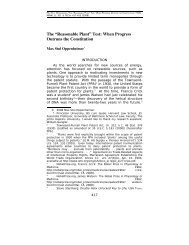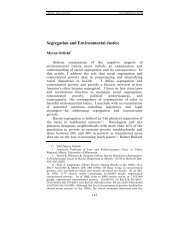An Organizational Approach to the Design of Patent Law
An Organizational Approach to the Design of Patent Law
An Organizational Approach to the Design of Patent Law
Create successful ePaper yourself
Turn your PDF publications into a flip-book with our unique Google optimized e-Paper software.
6 VERTINSKY FINAL_JAD (DO NOT DELETE) 2/27/2012 2:20 PM<br />
2012] AN ORGANIZATIONAL APPROACH 217<br />
havior in a way that can inform effective rule design. 17<br />
Adopting this way <strong>of</strong> thinking about patent law can improve<br />
policy decisions in significant ways. First, if patent policy<br />
is specifically designed <strong>to</strong> respond <strong>to</strong> flaws in human decision<br />
making, such as limited information and opportunism, it will<br />
be more robust in addressing <strong>the</strong>se flaws. By placing decisionmakers<br />
at <strong>the</strong> center <strong>of</strong> <strong>the</strong> analysis and recognizing <strong>the</strong> different<br />
mechanisms through which rules both influence and are influenced<br />
by human behavior, this approach can identify and<br />
encompass a broader range <strong>of</strong> functions for patents, including<br />
those <strong>of</strong>ten overlooked or ignored. 18<br />
Second, <strong>the</strong> organizational approach focuses specifically on<br />
how <strong>to</strong> align patent policy more closely with broader innovation<br />
goals. 19 By providing a commonality <strong>of</strong> purpose, that <strong>of</strong> using<br />
economic organization <strong>to</strong> increase innovation, this approach<br />
provides a way <strong>of</strong> mapping patent policy more readily in<strong>to</strong> <strong>the</strong><br />
areas <strong>of</strong> concern in national innovation policy. 20 For example,<br />
patent laws can be evaluated <strong>to</strong> determine whe<strong>the</strong>r <strong>the</strong>y facilitate<br />
or hinder clustering, public-private partnerships, and o<strong>the</strong>r<br />
types <strong>of</strong> arrangements that are <strong>the</strong> focus <strong>of</strong> current national<br />
innovation strategies. Moreover, once <strong>the</strong> value <strong>of</strong> patents <strong>to</strong><br />
national innovation objectives can be demonstrated, political<br />
17. The dangers <strong>of</strong> including <strong>to</strong>o much, as opposed <strong>to</strong> <strong>to</strong>o little, context in<br />
<strong>the</strong> analysis <strong>of</strong> legal rules is clear. See Eric A. Posner, Economic <strong>An</strong>alysis <strong>of</strong><br />
Contract <strong>Law</strong> After Three Decades: Success or Failure?, 112 YALE L.J. 829,<br />
838–39 (2003) (arguing that <strong>the</strong> economic analysis <strong>of</strong> contract law fails because<br />
<strong>of</strong> its indeterminacy). New Institutional Economics has been relatively<br />
successful in <strong>the</strong> development <strong>of</strong> analytical <strong>to</strong>ols that capture and examine<br />
empirical regularities, moving between observation and abstraction.<br />
18. Examples include transformative effects on potential entrepreneurs<br />
and expressive functions that reflect and encourage norms <strong>of</strong> information<br />
sharing or retention. Timothy R. Holbrook, The Expressive Impact <strong>of</strong> <strong>Patent</strong>s,<br />
84 WASH. U. L. Rev. 573, 575–76 (2006).<br />
19. Ted Sichelman makes <strong>the</strong> interesting point that <strong>the</strong> current system <strong>of</strong><br />
private law damages for patent infringement is inconsistent with a public law<br />
goal <strong>of</strong> using patents <strong>to</strong> increase innovation. He argues that patent law remedies<br />
should be designed <strong>to</strong> promote <strong>the</strong> types <strong>of</strong> levels <strong>of</strong> innovation that are<br />
most beneficial <strong>to</strong> society instead <strong>of</strong> being used <strong>to</strong> compensate for private<br />
wrongs inflicted on private parties. Ted Sichelman, Purging <strong>Patent</strong> <strong>Law</strong> <strong>of</strong><br />
Private <strong>Law</strong> Remedies, 4–5 (2011) (unpublished working paper), available at<br />
http://www.law.stanford.edu/display/images/dynamic/events_media/Ted%20Si<br />
cheman%20%20Purging%20<strong>Patent</strong>%20<strong>Law</strong>%20<strong>of</strong>%20Private%20<strong>Law</strong>%20Rem<br />
edies.pdf. I also argue that patent law should be designed in light <strong>of</strong> innovation<br />
outcomes, and suggest that one way <strong>to</strong> do this is <strong>to</strong> make <strong>the</strong> organization<br />
<strong>of</strong> innovation <strong>the</strong> central focus <strong>of</strong> patent policy.<br />
20. See Barnett, supra note 9; see also Robert P. Merges, supra note 15, at<br />
1516.






